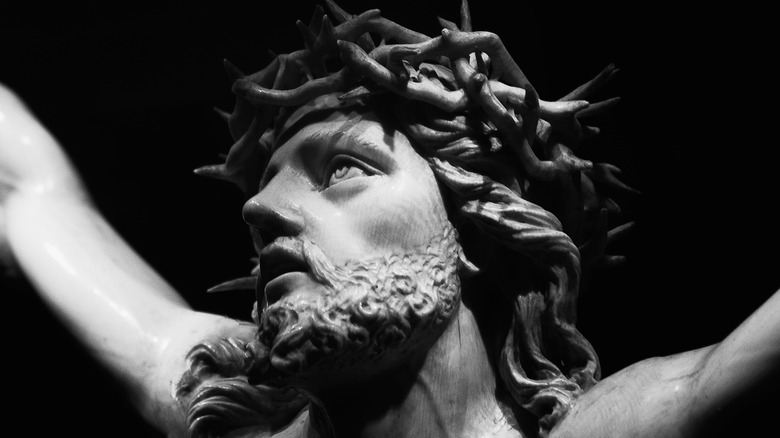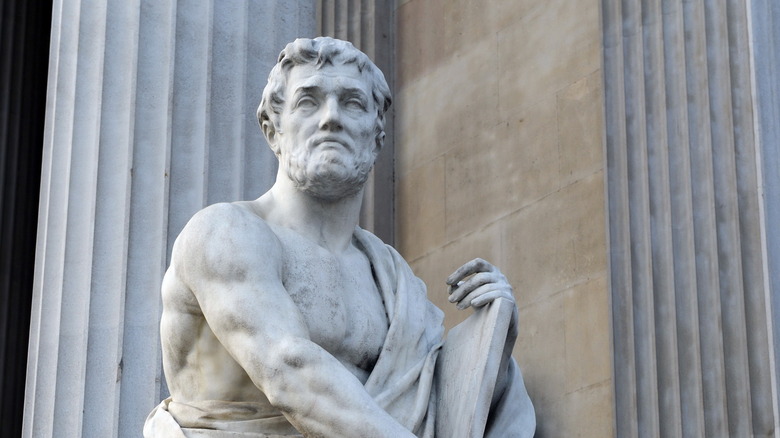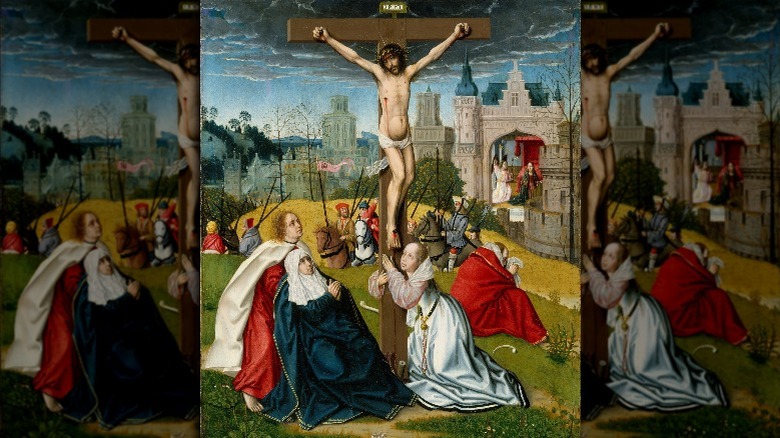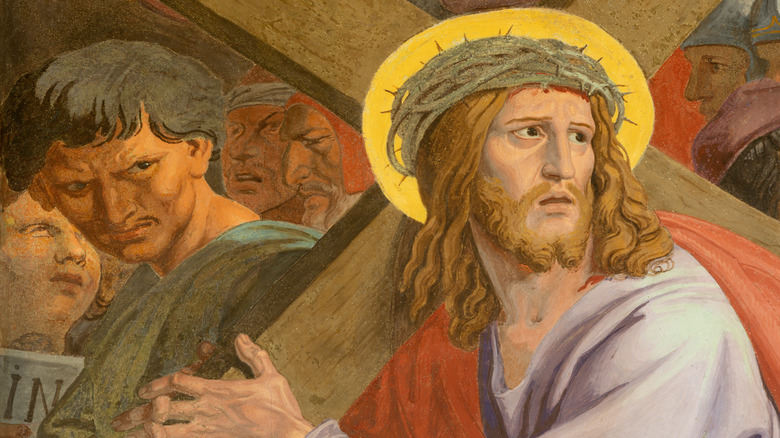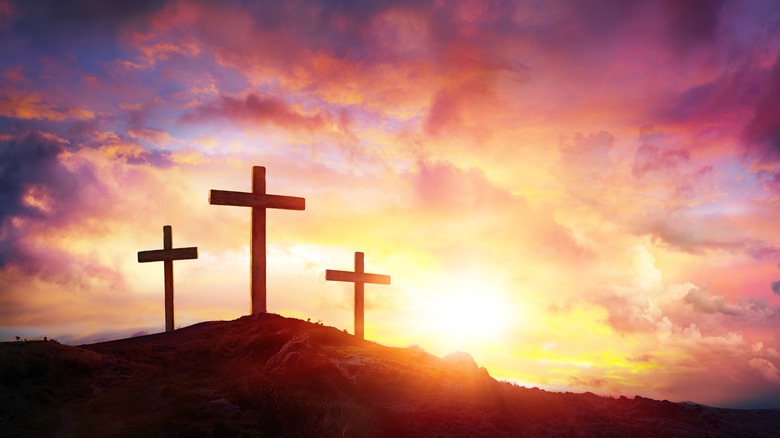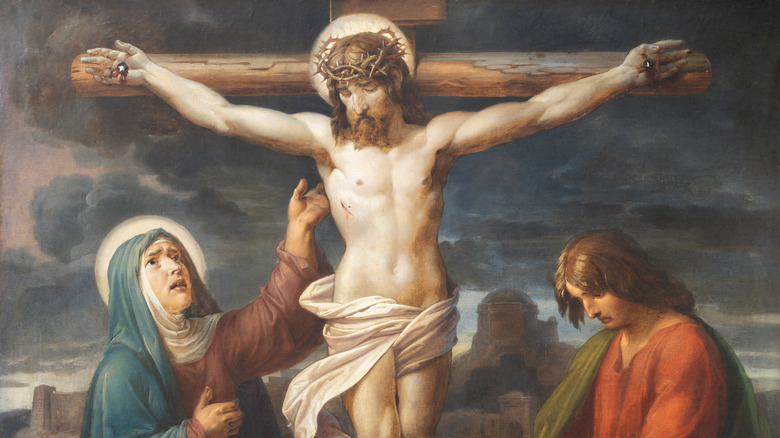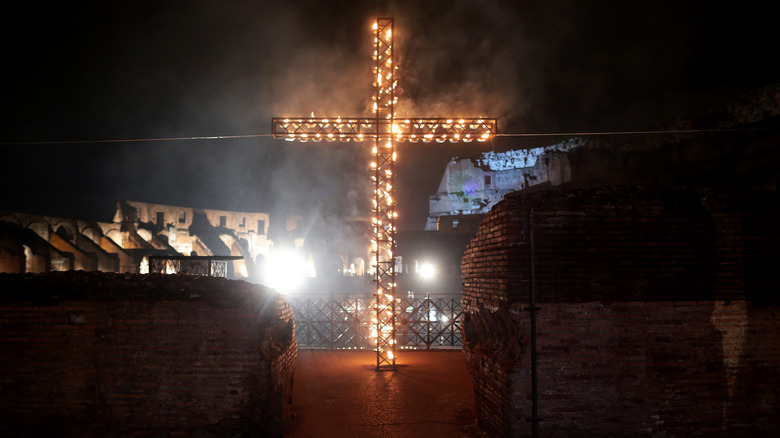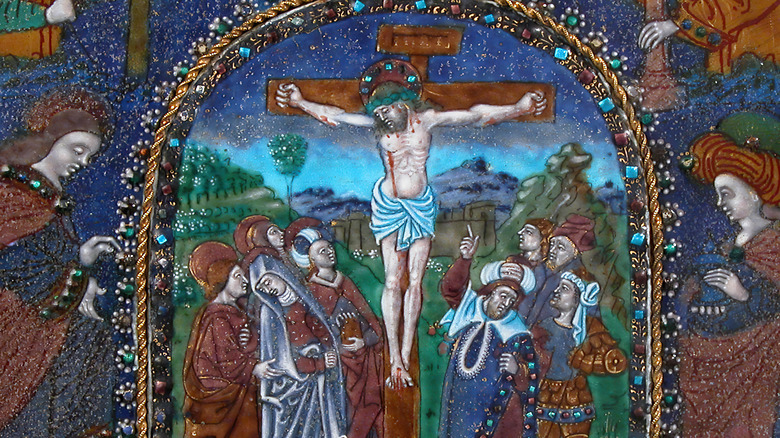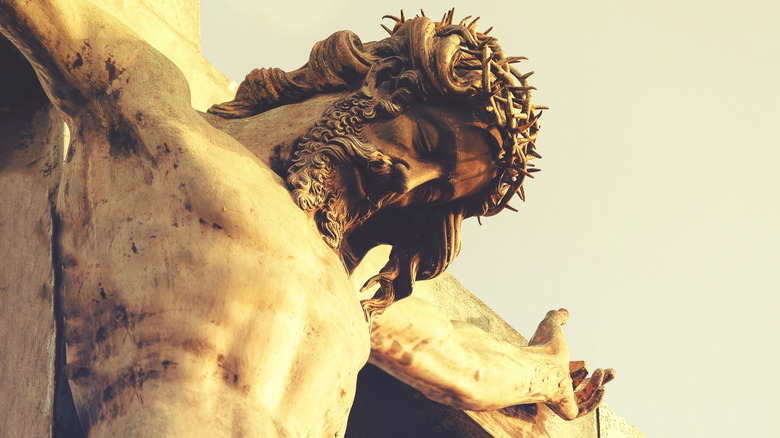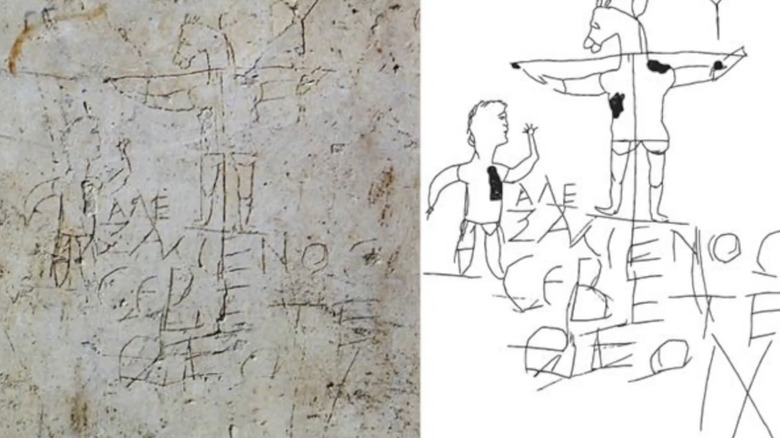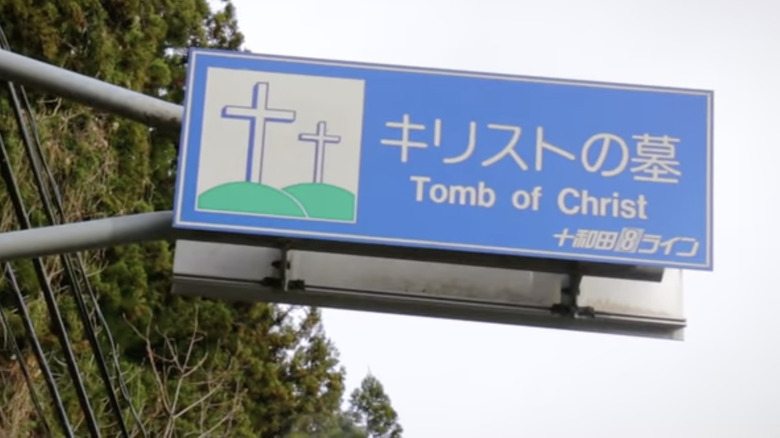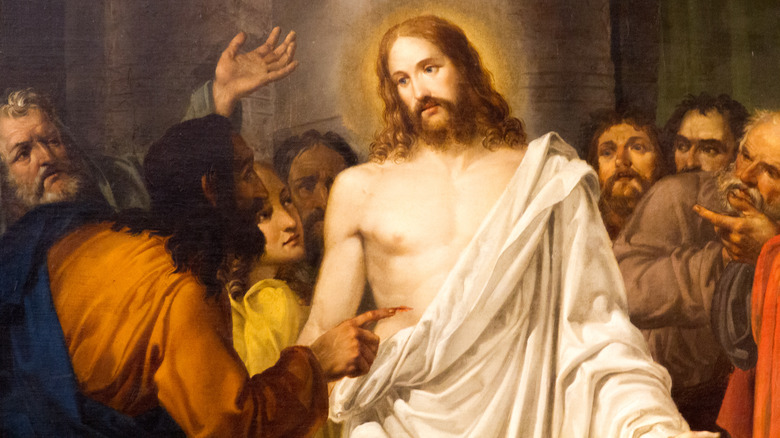The Crucifixion Of Jesus Explained
The Crucifixion of Jesus of Nazareth remains one of the most significant and polarizing events in world history, as explained by Faith Beyond Belief. The final 12 hours of Jesus' life are referred to collectively as the Passion. These fateful hours, including his trial, suffering, and death, have been depicted theatrically at Easter time since the Middle Ages through Passion plays, according to Britannica. Mel Gibson translated this tradition into a modern context with 2004's "The Passion of the Christ" starring Jim Caviezel.
The controversy surrounding Jesus' execution has inspired faith among some and disbelief among others. Initially, the event caused many of Jesus' disciples and followers to scatter in fear. Some, like Peter, denied him to avoid a similar fate, well-acquainted with the prevalence of crucifixion in first century Palestine. Yet, days later, the disciples reorganized with the shocking claim that Jesus resurrected from the tomb. And nearly 2,000 years later, 2.3 billion people still stake their religious beliefs on this claim, as reported by The Guardian.
Nevertheless, the Crucifixion of Jesus also raises many questions and controversies. For example, how could a pacifist Jewish rabbi run far enough afoul of Rome to warrant death as an insurrectionist? What ultimately killed him while on the Cross? And what does this story mean for people today? Here's the Crucifixion of Jesus explained.
What the ancients had to say about Jesus and his execution
Let's start with a simple question. How do we know that Jesus lived at all? After all, direct archaeological evidence of Jesus' life doesn't exist, per OpenMind BBVA. Yet, this isn't surprising. Associate Professor Lawrence Mykytiuk of Perdue University notes, "Peasants don't normally leave an archaeological trail" (via History).
Yet, scholars have still come to a consensus that Jesus of Nazareth did live. Why? Because of various historical references, both from biblical and non-biblical sources beginning in the first century. Mykytiuk points out that Jesus' existence was never debated in the ancient world, either. As he observes, "Jewish rabbis who did not like Jesus or his followers accused him of being a magician and leading people astray, but they never said he didn't exist."
Besides Christian narratives of the death of Jesus, non-Christian historical sources confirm the event and its aftermath. These include everything from a letter written by Mara bar Serapion to his son sometime after A.D. 73 to mentions in the work of Tacitus, Flavius Josephus, and Pliny the Younger (per Jesus Skeptic). According to Cambridge, the Babylonian Talmud also makes mention of Jesus' Crucifixion, stating, "On the eve of Passover Yeshu was hanged." (Yeshu or Yeshua was the Hebrew version of the Greco-Roman "Jesus.")
Christian narratives of the Crucifixion of Jesus
The New Testament contains the earliest references to Jesus' death on the Cross, per Agape Bible Study. The four canonical Gospels (Matthew, Mark, Luke, and John) offer nearly hour-by-hour accounts of the event, and there's also mention of this sacrifice in numerous places throughout Paul's letters.
Some people have questioned why these narratives don't go into greater detail about the crucifixion method itself. But it's important to remember that the first couple centuries of readers would've been personally familiar with this brutal punishment (via Church of Jesus Christ). These early audiences of the New Testament would have known about (and perhaps even seen) crucifixion, an inescapable part of daily life.
Live Science reports, "Thousands upon thousands of people were crucified, which at the time was considered to be one of the most brutal and shameful ways to die." Yet despite acquaintance with this form of execution, it proved so horrendous that even people who saw it regularly didn't get inured to it. The famed Roman philosopher and politician Cicero declared it "the cruelest and most disgusting penalty." And the Jewish historian Flavius Josephus referred to it as "the most pitiable of deaths."
The Stations of the Cross
Following his impromptu trials before Herod and Pontius Pilate, Jesus of Nazareth was scourged, tortured, and forced to carry the crossbar (or patibulum) upon which he'd get hung (via Cambridge). This excruciating journey has become known as the Via Dolorosa ("Way of Suffering"), as reported by Eternal Word Television Network (EWTN). Memorialized as the Stations of the Cross, this "14-step Catholic devotion that commemorates Jesus Christ's last day on Earth as a man" maps out the Via Dolorosa.
The trained eye will find these 14 steps preserved in small images or icons when touring a Catholic church or cathedral. For example, they're common motifs in stained glass. According to Catholic.org, those viewing these religious icons should pass from image to image, meditating and praying on what took place.
In this way, pilgrims and regular church attendees alike pass through all 14 stages chronologically, from Jesus' condemnation before Pontius Pilate to being laid in the tomb. Other significant steps along this journey include Station Five, the moment when Roman soldiers compelled Simon of Cyrene to shoulder the burden of the patibulum for Jesus (via Bible Study Tools). There's also Station Six, where Veronica wipes Jesus' face with her handkerchief, according to Britannica. Stations of the Cross rosaries aid believers in completing this journey of reflection.
Where Jesus was crucified
Roman authorities crucified Jesus at Golgotha, which translates as the "place of the skull" in Aramaic, as reported by the Public Broadcasting Service (PBS). Located outside Jerusalem, Latin-speaking Romans referred to Golgotha as "calvaria," which later generations of Christians would anglicize as Calvary. Where does this location lie today? The answer to this question remains disputed. According to Biblical Archaeology, the Church of the Holy Sepulchre ranks near the top.
Officially recognized as the site of Golgotha by Helena, mother of Constantine, the first Christian Roman emperor, it became the site of the iconic church. The church remained the undisputed location of Calvary until the 19th century when scholars questioned why it sat within the city walls of ancient Jerusalem. Both Jewish and Roman customs demanded that the crucified remain outside city walls. But even more recent archaeological work has demonstrated that Jerusalem's city walls were different in the first century, placing the Holy Sepulchre in the correct location after all.
Some Christians believe Golgotha and Mount Moriah represent the same location, as reported by the Dallas Leadership Foundation (DLFTX). Been a while since you dusted off a copy of the Old Testament? We've got you covered. Mount Moriah is where Abraham took his son Isaac to sacrifice him. Christians interpret the story of Isaac's near-sacrifice as a foreshadowing of the price paid by Jesus. So, placing Golgotha at or near the same spot as Mount Moriah represents a double whammy when it comes to religious significance.
Who witnessed the Crucifixion of Jesus
You might be surprised to learn that all but one of Jesus' disciples abandoned him after his arrest. According to Mark 14:50 (via Bible Hub), they all fled. We can presume they felt terrified at the prospect of what fate might befall them as associates of Jesus. It's also worth noting that despite television and film depictions of Jesus' disciples as mature men, they likely were much younger, according to AC3.
How do we know this? For starters, the apostles were all single except for Peter. Most Jewish men married around the age of 18, placing the unmarried disciples in their teens. (Not only does this explain their chaotic dispersal at Jesus' arrest, but it aids understanding of their immaturity at points in the Gospels.) What's more, they wrote New Testament documents well into the A.D. 70s and beyond, which also corroborates their youthful careers as Jesus' followers. The only disciple who refused to leave Jesus' side throughout the progression to and through crucifixion was John, likely no more than 14 or 15 at the time (via Grace Fellowship Church Omaha).
Besides John, a group of women observed the crucifixion, as reported by Christianity. They included the four Marys: Mary (Jesus' mother), Mary of Clopas (his aunt), Mary (James and John's mother), and Mary Magdalene (Jesus' follower). Crucified between two thieves, Jesus would've looked down onto a crowd of spectators that included Jewish and Roman authorities, centurions, and countless onlookers.
How Roman officials crucified Jesus
The Cross has long represented a symbol of Christianity. So, it might surprise you to learn that the practice of crucifixion in the fourth decade A.D. came with variations regarding the shape of the cross and the type of wood used (via Cold Case Christianity). While many Christians assume it was a cross-beamed crucifixion, some sects like Jehovah's Witnesses say he hung from a single pole. Why the disparity? It has to do with the ancient Roman practice of crucifixion.
Romans relied on four different structures for this mode of execution. The first was known as the crux simplex — an upright pole or stake. The victim's hands would've been bound by rope or nailed directly to the pole as would have been their feet. But Roman authorities also relied on the crux commissa (a t-shaped structure), the crux immissa (a crucifix shape), and the crux decussata (an X-shaped structure).
Of these, a crux immissa constructed from pine remains the likeliest instrument of Jesus' death (via CNN). Scholars point to early church iconography and writings for evidence. For example, the "Odes to Solomon" written between the 1st and 3rd centuries (and thought to be Christian) proclaim, "I extended my hands and hallowed my Lord, For the expansion of my hands is His sign, And my extension is the upright cross" (27:1-2). And Justin Martyr, who wrote in the second century, likened the Cross to a staysail or sail mast.
What Jesus said from the Cross
Comparing the Gospels provides a window into what may have been Jesus' final words and teachings from the Cross. These sayings include the quote, "My God, my God, why have you forsaken me?" (via FaithGateway). This would have been a well-recognized verse from the Hebrew Bible's (Old Testament's) Psalm 22. Early Christians interpreted Psalm 22 as a prophetic description of the Messiah's execution. Written about 1,000 years before his birth and quoted in Matthew 27:46, the phrase served as confirmation of Jesus' identity as the Jewish Messiah, per Christianity.
But the powerful last sayings of Jesus from the Cross don't end there. In Luke 23:24 (per Christianity), the author depicts Jesus praying for those punishing him: "Father, forgive them, for they do not know what they are doing." A surprising prayer for the authorities tormenting him to death, these words also fulfill prophecies from the Book of Isaiah about a Messiah who would intercede on the people's behalf.
Among his other poignant sayings was the commandment to the Apostle John to adopt his mother, Mary, as family. In this way, Jesus ensured his mother (a widow at the time) would have someone to look after and support her. Of course, what Jesus says from the Cross culminates with the words, "It is finished." Christians interpret this as referring to the redemption price paid by Christ to free humanity from the curse associated with the Fall of Adam and Eve in the Garden of Eden.
Supernatural events that followed Jesus' Crucifixion
In the immediate aftermath of Jesus' Crucifixion, the Gospel accounts tell us things took a turn for the eerie, according to Kearney Hub. Three of the four accounts report strange events, including a period of darkness following his death. And this episode of sunlessness is further supported in contemporary documents from non-Christian sources.
Two historians mention this strange episode of darkness, the Samarian Thallus and Phlegon, author of the "Olympiads." Although their complete writings got destroyed over time, both historians would be cited by other ancient sources, including Philopon, Julius Africanus, and Origen. Writing in A.D. 221, Africanus noted, "Thallus, in the third book of his histories, explains away this darkness as an eclipse of the sun — unreasonably, as it seems to me ..."
But what about other abnormal events mentioned in the New Testament, such as an earthquake, the opening of tombs, and the tearing of the veil in the Second Temple? Origen wrote about all these events. He also states that "darkness prevailed in the daytime, the sun failing to give light." As reported by NBC News, a group of geologists has pinpointed Jesus' most likely Crucifixion date to April 3 in the year 33 A.D., based on a review of ancient seismic activity. They completed this review using three cores taken from the Dead Sea's beach at Ein Gedi Spa. These core samples provide information about two major earthquakes that rocked the area at that time, including the event they believe coincided with Jesus' death.
A medical perspective on crucifixion
Despite the horrors Jesus endured during his crucifixion, including scourging, beatings, and being nailed to a cross, medical examiners and physicians have long debated precisely what killed him (via All About Jesus Christ). Some have hypothesized cardiovascular collapse, while others have argued profound shock, exhaustion asphyxia, or a combination of several factors.
Joseph W. Bergeron identifies six potential contributors to the rabbi's death. They include cardiac rupture, pulmonary embolism, asphyxiation, shock, suspension trauma, and a stab wound made by a Roman soldier with a spear. What conclusion does Bergeron come to, based on his deep dive into the subject? "Traumatic shock complicated by trauma-induced coagulopathy is proposed as a contributing factor, and possibly the primary mechanism, of Jesus' death by crucifixion."
In their work "The History and Pathology of Crucifixion," F.P. Retief and L. Cilliers also speak to the many traumas inflicted on crucifixion victims and their after-effects, including severe pain and various physical wounds dealt by the soldiers. No matter the ultimate cause of death, it's clear that Jesus spent hours enduring sustained torture that could only be described as excruciating. (It's no coincidence that the word "excruciating" finds its origins in the act of crucifixion, literally meaning "out of the cross," according to Live Science).
What the Cross means to Christians
Instead of viewing Jesus' death as the tragic martyrdom of a sage religious leader, Christians argue it fulfilled prophesies of the Old Testament, from the Psalms to Isaiah and Zechariah (via Chron). These prophecies refer to a "Suffering Servant" who would be "pierced through" to atone for the wrongdoings of humanity, as stated in Isaiah 53:5 (via Bible CBN). They see the act as a payment for the world's sins, permitting reconciliation between a Holy God and humanity.
That said, many people have wondered: Why crucifixion? After all, it represented a humiliating and torturous experience generally reserved for the lowliest slaves and criminals. Some ancient Romans even mocked the inglorious way that Jesus died. Created by a pagan, the A.D. 200 Alexamenos graffito depicts Jesus with the head of a donkey (via Art and Theology). Why? Because by pagan standards, crucifixion represented a foolish way for a "god" to die. (Remember, the main thing separating pagan gods from humans was immortality, meaning gods couldn't die.)
But the early writers of Christianity saw religious harmony in how the Crucifixion reconciled with Old Testament prophecies. They poured over these ancient writings, finding numerous allusions to the Cross. As reported by the Christian Broadcasting Network (CBN), "it is clear that crucifixion was the only death that would fulfill the Old Testament prophecies, the predictions, of what would happen to the Messiah." What's more, Christians would argue that the harsh punishment made sense as an atonement for all human sin.
Why some deny the Crucifixion of Jesus
Known as "Isa" in Arabic, Jesus is fundamental to Islam (via Vox). Muslims acknowledge the virgin birth, Isa's healing miracles, and his role as a prophet of Allah. They believe Isa will return at the end of the world for a showdown against al-Masih ad-Dajjal, the "false messiah." But Muslims don't put stock in Isa's divinity or the Crucifixion, per Gregory R. Lanier.
Rejection of the Crucifixion has roots in Gnosticism, too. Docetists believe Jesus' incorporeality superseded anything humans could do to physically harm him (per New Advent). Instead, he got translated from the Cross directly into heaven. Some Gnostics and Muslims also argue that Simon of Cyrene, Judas Iscariot, or a Roman soldier died in Jesus' place.
And then there's the village of Herai (modern-day Shingo) in northern Japan. Per the Smithsonian, residents of Herai claim Jesus came to Japan at 21, seeking education. In his early 30s, he returned to Judea, teaching about the faraway kingdom of Japan. This raised the ire of local officials leading to the crucifixion of his brother, Isukiri. Escaping back to Japan, Jesus settled in Herai, had a family, died at 106, and remains buried there, as reported by Unusual Places.
Death, resurrection, and archaeology
Despite these variations on Jesus' life, recent archaeological finds show interesting similarities to some claims made in the Gospels (via Leader U). They include the remains of Yohanan ben Ha'galgol, crucified in the first century. A 28-year-old Jew, he once stood five feet six inches tall and was crucified like Jesus. Ha'galgol had 7-inch-long nails driven through the Achilles tendon of each foot and through his lower forearms.
There's also evidence related to the Resurrection. Archaeologists have uncovered the inscription of a decree from Emperor Claudius, threatening severe punishment for body snatching. The decree, written just a few years after Jesus' Crucifixion, extends the death penalty for anyone caught moving or otherwise making a body disappear. Normally, such a crime would come with a fine, which has piqued researchers' interest: "This decree was probably made in connection with the Apostles' preaching of Jesus' resurrection and the Jewish argument that the body had been stolen."
Per Bible Study Tools, the story of a penniless rabbi crucified presented little historical traction without the Resurrection. Jesus' disciples had scattered, and many thought the Jesus movement died on the Cross. Instead, the first Christians claimed the anastasis or Resurrection of Jesus of Nazareth. This contention remains the cornerstone of Christianity, providing the ultimate confirmation of Jesus' divinity in the eyes of believers (per Pluralism).
